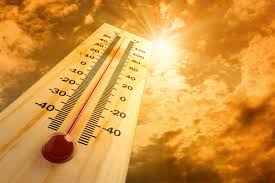Too hot to fly: rising heat may ground planes
LONDON, 14 July, 2017 – US scientists have just added a new dimension of horror to the modern airport experience: global warming could take heat wave temperatures to the point where it becomes simply too hot to fly.
And as the mercury rises, those aircraft that are cleared for takeoff may have been forced to take off a dozen protesting passengers, to lighten the load and get the rest of them safely off the ground.
Aircraft now contribute an estimated 2% to the greenhouse gas emissions that generate global warming. In the course of 2016, according to the World Bank, 3.7 billion people took flights, so even a small percentage of disruptions could affect huge numbers and keep them, fuming with impatience, in the flight lounges.
According to researchers from the Lamont-Doherty Earth Observatory at Columbia University, disruption is on the way.
Offloads needed
They report in the journal Climatic Change that, if humans continue to burn fossil fuels at an accelerating rate, and as average global temperatures creep up by the predicted 4°C above historic levels, then on the hottest days, between 10% and 30% of fully-loaded planes may have to remove fuel, cargo or passengers before they can take off: either that, or flights will have to be delayed to the cooler hours.
This is not the only problem that global warming and associated climate change will deliver to the airlines. Other researchers have warned more than once that as temperatures rise, so will the challenge of clear air turbulence.
But passengers won’t just have to keep their seat belts locked, they may have to stay locked in for longer, as jet stream wind patterns change. Other research teams have found that slower progress against headwinds will mean dramatic increases in fuel demands.
Too heavy
But the Columbia team may be the first to have thought about the problems that warming will bring to the airport tarmac. Warmer air means thinner air. As the air thins, wings generate less lift as the plane accelerates along the runway. If the temperature gets too high, the plane may be too heavy to take off at all.
Average global temperatures have increased by almost 1°C since 1980. Late in June, American Airlines cancelled more than 40 flights out of Phoenix, Arizona as daytime temperatures inched up to 48°C.
And heat waves are expected to become more frequent, more prolonged and more intense with global warming. By 2100, temperatures on airport runways could have reached 4°C to 8°C higher than they are now.
The Columbia scientists considered the performances of five Boeing and Airbus commercial aircraft, and 19 major airports, and then worked with projections of future climate change to see how this would affect air traffic.
“This points to the unexplored risks of changing climate on aviation. As the world gets more connected and aviation grows, there may be substantial potential for cascading effects, economic and otherwise”
They found that tomorrow’s aircraft would have to lose weight to gain altitude: up to 4%. For an aircraft of 160 seats, this would mean the loss of 12 or 13 passengers.
“Our results suggest that weight restriction may impose a non-trivial cost on airlines and impact aviation operations around the world,” said Ethan Coffel, a Columbia University doctoral student. “The sooner climate can be incorporated into mid- and long-range plans, the more effective adaptation efforts can be.”
And his co-author Radley Horton, a climatologist at Lamont-Doherty Earth Observatory, said: “This points to the unexplored risks of changing climate on aviation.
“As the world gets more connected and aviation grows, there may be substantial potential for cascading effects, economic and otherwise.” – Climate News Network








